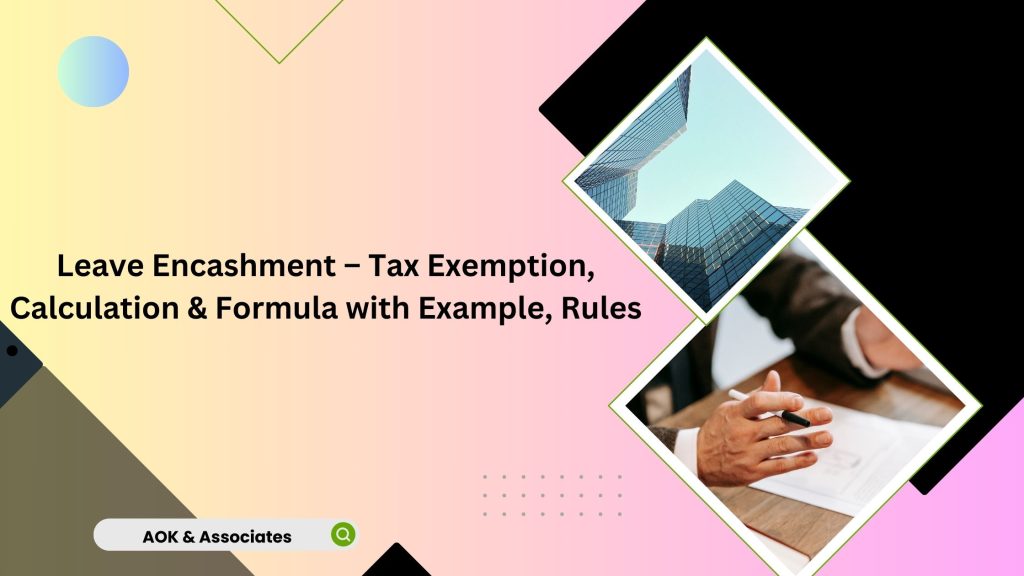Have you ever heard the term ‘leave encashment’ and wondered what it means?
For salaried employees, leave encashment is a crucial aspect of compensation. It allows employees to convert their unused leaves into financial benefits.
In this guide, we’ll explain what leave encashment is, how it works, and its tax implications.
What is Leave Encashment?
As per labor laws, salaried employees are entitled to a set number of paid leaves annually. However, not all employees utilize their entire leave quota. Many companies have policies allowing employees to carry forward unused leaves, leading to an accumulation over time.
Upon retirement, resignation, or under certain circumstances, employees receive compensation for their unutilized paid leaves. This process is known as leave encashment.
Types of Leave
Companies establish their own leave policies, defining different categories of leave. Though policies may vary, common types of leave include:
- Casual Leave – Typically ranging from 7 to 10 days per year, casual leave is used for personal matters. Encashment depends on company policy.
- Earned Leave (Privilege Leave) – Employees can avail of these leaves with prior approval. Many companies allow encashment after a specified period.
- Medical Leave – Granted for health-related issues, the number of paid medical leaves varies by organization.
- Holiday Leave – These are official holidays where employees get paid time off, determined by company policy.
- Maternity Leave – Exclusively for female employees, maternity leave can range from 12 to 26 weeks. Extended maternity leave may not be paid and is non-encashable.
- Sabbatical Leave – Employees may take sabbaticals for personal or professional development. Some employers offer reimbursement during this period.
Understanding leave encashment helps employees maximize their benefits while ensuring tax compliance. Let’s explore the taxation aspect of leave encashment.
Taxation of Leave Encashment
Leave Encashment During Employment
If an employee encashes leave while still employed, the entire amount is treated as taxable salary income.
However, tax relief can be claimed under Section 89 of the Income Tax Act. To avail of this benefit, employees must file Form 10E on the income tax portal. This can help reduce the tax burden associated with leave encashment.
Leave Encashment on Retirement or Resignation
When an employee resigns or retires, leave encashment may be fully or partially exempt from tax, depending on the category of employment:
| Employee Category | Tax Treatment |
|---|---|
| State and Central Government Employees | Fully tax-exempt |
| Non-Government Employees | Partially exempt under Section 10(10AA)(ii); the remaining amount is taxable |
| Legal Heir of a Deceased Employee | Fully tax-exempt |
Leave Encashment Calculation
For non-government employees, the exemption amount is determined using the following formula:
Updated Exemption Limit:
The tax exemption limit has been raised from ₹3 lakh to ₹25 lakh.
| Particulars | Amount (₹) |
| Leave Encashment Received (A) | XXXX |
| Less: Exemption under Section 10(10AA) – Least of the following (B): | XXXX |
| (i) Government Notified Limit (₹25,00,000) (C) | 25,00,000 |
| (ii) Actual Leave Encashment Received (D) | XXXX |
| (iii) Average Salary of Last 10 Months (E) | XXXX |
| (iv) Salary per Day × Unutilized Leave (Max 30 Days per Year) × Completed Years of Service (F) | XXXX |
| Taxable Leave Encashment: (A) – (B) | XXXX |
Understanding how leave encashment is taxed allows employees to make informed financial decisions. If you need assistance with calculations, consult a tax professional for personalized guidance!
Frequently Asked Questions (FAQs)
1. What is leave encashment?
Leave encashment refers to the compensation received by an employee for unutilized paid leaves, either during employment or at the time of resignation or retirement.
2. Is leave encashment taxable?
Yes, leave encashment is taxable. However, exemptions are available based on employment category and specific tax provisions.
3. How can I claim tax relief on leave encashment?
Tax relief can be claimed under Section 89 of the Income Tax Act by filing Form 10E online through the income tax portal.
4. Can leave encashment be availed while still employed?
Yes, some employers allow leave encashment during employment, but the amount received is fully taxable.
5. Is there a limit on tax exemption for leave encashment?
Yes, for non-government employees, the maximum exemption limit for leave encashment has been increased to ₹25 lakh.
6. Are all types of leaves eligible for encashment?
No, not all leave types are eligible. Typically, earned leave is encashable, while maternity leave, medical leave, and casual leave may not be encashed based on company policy.
7. Does leave encashment apply to private sector employees?
Yes, private sector employees can receive leave encashment, but it is partially taxable as per Section 10(10AA)(ii) of the Income Tax Act.
8. How is leave encashment calculated?
Leave encashment is calculated based on the last drawn salary, unutilized leave days (up to 30 days per year), and total years of service.
9. What happens if an employee passes away?
If an employee passes away, the leave encashment amount received by the legal heir is fully tax-exempt.
10. Should I consult a tax expert for leave encashment planning?
Yes, consulting a tax expert can help you optimize tax benefits and ensure compliance with applicable tax laws.


